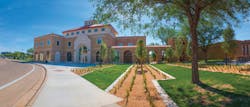Industry donations make an impact on Texas Tech
Nestled in the South Plains of Texas, not far from the white-hot Permian Basin, sits Texas Tech University. There, you'll find The Bob L. Herd Department of Petroleum Engineering. Home to one of the largest petroleum engineering departments in the country, Texas Tech is a major producer of petroleum engineers-and the industry has taken notice. With generous donations from various individuals and companies in the oil and gas space, Texas Tech is poised to produce even more industry-ready Red Raiders.
In February of this year, a ribbon cutting ceremony marked the opening of the new $22.8 million Terry Fuller Petroleum Engineering Research Building's cluster of laboratories.
The result of various donations, the new building and laboratories are named after Texas Tech alum and long-time donor Terry Fuller. Fuller, president and founder of McKinney, TX-based Phoenix PetroCorp., and his wife Linda, also a graduate of Texas Tech, were major contributors to the cost of the research building that now serves as a facility that integrates formal teaching environments with hands-on practical applications. Within the building are laboratories, as well as teaching and research areas named for various corporate donors including Anadarko, Apache, Chevron, LINN Energy, Oxy, and Pioneer Natural Resources. A space named for Michael Herd, vice president of Herd Producing Co., can also be found. Michael Herd serves as president of the Bob L. Herd Foundation, which was established by his grandfather, Bob L. Herd, a 1957 Texas Tech petroleum engineering graduate and namesake of the Bob L. Herd Department of Petroleum Engineering.
The department is currently deemed one of the largest for petroleum engineering in the country, averaging more than 500 students, thus Texas Tech one of the leading producers of industry-ready petroleum engineers. The addition of the new, 42,000 square foot building will allow the department to grow even more, providing formal teaching environments with hands-on practical applications to more than 600 undergraduate students using cutting-edge research facilities and techniques.
Thanks to a recent $1.25 million donation from Englewood, CO-based information and insight provider IHS, Tech engineering students gain access to IHS Petra®, a software tool used for geological, engineering and petrophysical analysis. The PC-based tool is used by geoscientists and engineers to visualize, analyze, and manage well production, well log, drilling, reservoir and other related information and includes a database of more than 3.5 million current and historic well records from across the world.
"Many E&P companies, especially independents, use this IHS software," said Marshall Watson, chair of the Herd Department of Petroleum Engineering at Texas Tech. "Having basic knowledge of the insight and analysis it provides will give our undergraduate students a real competitive advantage in job placement."
"We are pleased to be able to make this significant gift of IHS Petra to Texas Tech, which is a global leader in both education and research for the petroleum engineering community," said Russ Sagert, vice president of energy software products at IHS. "This software will ensure that Texas Tech students have industry-leading technology at their fingertips, and will help them transition to the workforce, since many oil and gas companies require their interpreters and engineers to have experience with our IHS applications, including IHS Petra."
The license, valued at $1.25 million, will allow up to 150 students to work on the software at the same time, enhancing students in the program at Texas Tech.
"Once implemented, we will use the software for teaching undergraduate classes," said Watson. But it won't stop there. Once data is assembled, he continued, "it can be shared with other universities in an overall senior-design-project exchange plan to help each other with creating a portfolio of design projects."
The collaboration of industry, education, and facilities is sure to extend the reach of The Bob L. Herd Department of Petroleum Engineering, Texas Tech University, and its students far beyond the windy Plains for generations to come.
About the Author
Mikaila Adams
Managing Editor - News
Mikaila Adams has 20 years of experience as an editor, most of which has been centered on the oil and gas industry. She enjoyed 12 years focused on the business/finance side of the industry as an editor for Oil & Gas Journal's sister publication, Oil & Gas Financial Journal (OGFJ). After OGFJ ceased publication in 2017, she joined Oil & Gas Journal and was named Managing Editor - News in 2019. She holds a degree from Texas Tech University.


